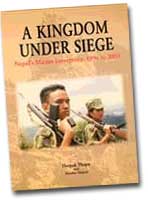 Just a few years ago, there was a time when uttering the word 'Maoist' at a gathering of Kathmandu's English-speaking elite would raise concerned eyebrows and usher in a moment of awkward silence. For many residents of the urban centre, this period was marked by fear of the unknown and incomprehension of the insurgency that was sweeping rural Nepal. The accomplished journalist and editor Deepak Thapa, together with a handful of notable others, can be credited with changing that.
Just a few years ago, there was a time when uttering the word 'Maoist' at a gathering of Kathmandu's English-speaking elite would raise concerned eyebrows and usher in a moment of awkward silence. For many residents of the urban centre, this period was marked by fear of the unknown and incomprehension of the insurgency that was sweeping rural Nepal. The accomplished journalist and editor Deepak Thapa, together with a handful of notable others, can be credited with changing that. In 2003, continuing to fill what was fast becoming a niche market, Thapa edited a collection of writings (most of which had been previously published) of wide-ranging perspectives on the Maoist insurrection, aptly titled Understanding the Maoist Movement of Nepal. The present book, A Kingdom Under Siege, was published during the second ceasefire in the eight-year old conflict (in the first half of 2003), and is Thapa's latest contribution to the growing body of literature which surveys the state of the movement and its historical origins. In this volume, with input from Bandita Sijapati, Thapa describes the Nepali state's neglect of many of its citizens, the instabilities of the polity and the rise of radical left politics in the mid-western region of Nepal, which quickly emerged as the Maoist heartland. Given all that has transpired since the most recent talks collapsed, Thapa may well be thinking about a sequel.
Chapter One contains a short set of sobering anecdotes about individual lives affected by the insurgency and Chapter Seven addresses the state of play during the second ceasefire, and offers some concluding thoughts. In between, a long second chapter takes the reader on a tour of the history of modern Nepal, from the formation of the nation-state in 1768-69 to the first indications of Maoist insurrection in western Nepal in 1996. While the history is solid and undoubtedly of utility to readers wanting a potted account in under 40 pages, at times it plods along with an over-reliance on dates, names and facts that are not immediately relevant. The overview is useful, however, and well referenced to a set of primary texts and resources in the end notes for those interested in further reading.
The next chapter, Understanding the Causes of the 'People's War', is by far the strongest in the book and makes for engaging reading. Thapa is at his best when providing prudent commentary on facts rather than presenting only facts themselves, and he starts in the right vein by noting that most of the Maoist demands are "reasonable and not dissimilar in spirit to the election manifestos of mainstream parties" (page 53). This chapter may also be read as a damning indictment on central government planning and the development industry, noting as it does that poverty outpaces growth and lamenting the "economic dualism"
(page 60) of the urban-rural split in Nepal. While Thapa's critique is hard-hitting and addresses the feelings of marginalisation and frustration among Nepal's half-educated rural youth, his suggestion that "much of the Maoist appeal lies not in the resonance of Marxist theory among poor and often illiterate villagers" (page 64) is questionable and may contribute to the unfortunate misconception that rural villagers are ignorant of radical ideology and less than full political agents.
Chapter Four addresses the growth of the Maoist movement since 1996. Thapa deals in turn with the government's initial chaotic response, the little-known but fascinating Dhami report, Kilo Sierra Two and the political and military actions of the police, Maoists and army. The following chapter, Two Momentous Years of 2001 and 2002, includes the Palace Massacre of June 2001, the emergence of "overground" Maoists and the hope for peace negotiations. The authors have chosen to box salient events, such as the Dang and Salleri attacks
(Box 9, page 122) and the Arghakhanchi rout of September 2002 (Box 10, page 130). The effect is convincing and allows readers to pause momentarily on a single incident and reflect on its significance.
Chapter Six assesses the cost of the conflict to date, in both human and economic terms. The data are grave: profound contractions of GDP during the last years of the conflict, massive insurance claims, widespread destruction of infrastructure and a terrible loss of human life. The presentation is cogent and the analysis carefully-worded, with such thoughtful asides as: "In a country where illiteracy, lack of proper health services and poverty are rampant, there is a strong debate about whether weapons will necessarily provide the country with security" (page 148).
The lack of polemic which characterises Thapa's journalistic style is genuinely refreshing and deserves special mention. The book's greatest shortfall is the regrettable lack of analysis, an absence which is all the more noticeable since, when the author does engage critically with the subject matter, his insights are always sharp and pertinent. The conclusion is a case in point: while no one could disagree with the suggestion that the only way to bring about a lasting peace is to build a state that is equally attentive to the interests of Nepal's diverse population groups, readers will have to wait for Thapa's next instalment for a compelling vision of how to get there.
Mark Turin is Director of the Digital Himalaya Project based jointly at the University of Cambridge and at Cornell University.


